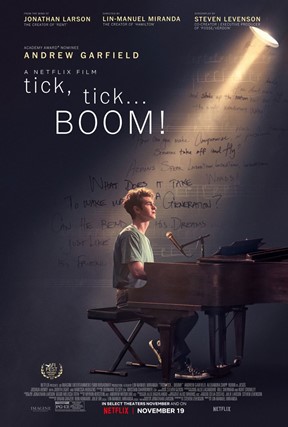tick… tick… BOOM! – The Musical Revival Of Jonathan Larson

tick, tick… Boom! premiered on Netflix in November
tick… tick… BOOM! – The Musical Revival of Jonathan Larson
The revival of Jonathan Larson’s off-Broadway autobiographical musical, tick…tick…BOOM!, has been widely acclaimed in its new movie musical. Andrew Garfield stars as Jonathan Larson, the playwright who struggles to complete his musical, Superbia, before his 30th birthday. The Netflix original movie debuted on November 12, 2021, and since then, the musical’s accompanying album has taken the theatrical world by storm.
The album opens with the dynamic sound of “30/90”; a high-energy track featuring Andrew Garfield on lead vocals and other award-winning musicians such as Vanessa Hudgens and Robin de Jesus on supporting vocals. The piece begins with a scattered chord progression on piano, slowly increasing in speed until the entrance of Garfield’s first set of lyrics, where he expresses his desire to “stop the clock” and “take time out.” The personification of Larson’s anxiety is masterfully displayed throughout the opening piece, with one example being the consistent ticking noise he chooses to weave in the background of the piece. “30/90” first introduces watchers to the phenomenon in which the musical earns its name. During points of contention in the movie, a crescendo of ticking can be heard in the background when tensions rise.
Anxiety and longing are commonly disguised within glamourous, vibrant songs on the album. “Swimming” takes place at the climax of Larson’s internal struggle during the story. Lyrics are effectively stacked upon one another to display the inner turmoil of the character as he fails to sort his thoughts. The heavy rock bassline lays foundation for a thick chord progression in the electric guitar to create a dense feeling in the music itself.
“Therapy” continues the theme of hiding serious messages within joyfully toned movements. The country-meets-music-theater tune duets Garfield and Hudgens, as it tells the story of a couple reaching the breaking point of their relationship. The singers successfully experiment with complex rhyme schemes and repeating vocal stims throughout the piece, accompanied by traditional acoustic guitar and banjo. The playful banter creates a warm, inviting sound, yet the overlap of the lyrics expresses the couple’s inability to communicate both in real life and as the song progresses. “If you don’t have a problem with my problem/ Maybe the problem’s simply codependency….?” Garfield exclaims with a humorous tone towards his girlfriend, who responds later with a brilliantly confusing play-on-words: ‘I didn’t know, that you didn’t know/ That when I said ‘No,’ I meant ‘Yes, I know,'” displaying the comical miscommunications between the two.
Larson has proven to be no stranger to ballad-style pieces either. Songs such as “Johnny Can’t Decide” and “Come to Your Senses” mellow the typical dance numbers seen on the rest of the album; Larson swaps rhythmic synthesizer and rock-style basslines that he’s shown to favor for gentle acoustic guitars and soulful piano. Other songs, such as “Why,” strip the backgrounds entirely, opting for Garfield’s vocals and newly acquired ballad-style piano skills.
One of the most popular songs on the album consists of no instruments at all— “Boho Days” is another of Larson’s songs in which he trades traditional instrumentation for rhythmic clapping and vocal harmonics from party guests. Larson continues to personify his multitude of fears throughout the song, prompting Garfield to express, “The time is flying, and everything is dying/ I thought by now I’d have a dog, a kid, a wife!” He goes on to repeat the chorus over a delightfully coordinated clapping rhythm, “This is the life, a bo-bo-bo-bo!” The lyrics highlight the many guests at Larson’s party where the scene takes place. He expresses how his discontent with settling down has allowed him to continue dreaming and striving for more in life. Through the piece, by choosing different names and scenarios of his party guests, Larson urges those who struggle to find their role in life to continue and not settle for their current position.
Overall, Jonathan Larson’s brilliant work triumphs again. From classic theater style songs to high-energy country and ballads that disguise common struggles, Larson creates a unique musical experience for all willing to listen. Rating: A








